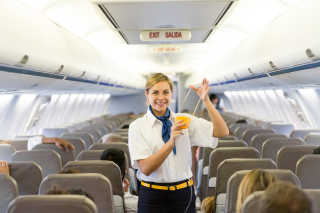How do I prepare for an airline emergency
In this fast and modern life, air travel has become more popular than any other type. People prefer air travel because of the fast speed, comfort, and convenience that it offers. It is also one of the safest methods of transportation. But air transport carries certain disadvantages. A minor airplane accident is likely going to spell total disaster and loss of life. To prepare for airline emergencies that may arise during your travel, it is always wise to be prepared.
- Book direct flights
- Stay seated
- Pay attention to the safety briefings
- Know where the exits doors are located
- Know where the life jacket is
- Leave your bags
Book direct flights
According to air experts, most plane accidents occur during take-off and landing. So to minimize the risk of being involved in an air traffic emergency, simply lower the number of take-offs and touchdowns by taking non-stop flights. If possible, avoid flights with connections. This way, you will only be taking off and landing once per trip.
Stay seated
In case of an emergency, remain in your seat, keep calm, and follow procedures given. This will make the flight attendants' work easy to keep you and the rest of the vehicle safe. Even when the "no seatbelt required" light flashes on, it's a good idea to stay buckled up. It could save you from getting thrown out of your seat and hurting yourself or someone else during periods of turbulence.
Pay attention to the safety briefing
One of the simplest things you can do to increase your safety on a plane is to pay attention to the briefing at the beginning of each flight. Turn off the WiFi and entertainment to listen to the flight attendant This will prepare you mentally for any emergency. People who are mentally ready for a disaster such as a plane crash have a higher chance of survival. Even when you think you know all the instructions and have heard them a hundred times before, each airline has its own safety debrief that could contain crucial new information.

Know where the exits doors are located
In the event of an emergency, exiting the plane quickly is a crucial factor. Therefore, after boarding a plane and once seated, look around, study the seat layout, and note where the exit doors are, both in front and in back. It is useful to know this information just in case any emergency arises. This is another great reason to actually listen to the safety announcement!
Counting how many seats there are between you and the nearest exit is also essential for dealing with fire emergencies, as smoke can impair vision and make it difficult to see the correct path. Additionally, keep in mind that if you are seated in an emergency exit row, you must be willing and capable to help other passengers to exit before yourself.
Know where the life jacket is
Knowing the exact place where the life jacket is can both prevent plane accidents and make emergencies easy to handle. The life jacket is usually placed underneath your seat, and tampering with it is a criminal offence. In case of an airline emergency, wear the life jacket, tighten the straps and wait for further instruction.
It is equally important to familiarize yourself with the instructions on the picture card in front of each seat. Not only will this tell you where everything is in case of an emergency, but it will have the most relevant information for the particular plane you're flying.
Leave your bags
In the event of an evacuation, leave all your luggage behind as the most important thing is to get yourself and the other beings out of the aircraft. Precious seconds are lost when those onboard decide their laptop bag is worth going back into the plane for - you don't want to be the reason someone gets seriously injured, or worse, during a plane accident. Do not think of taking your bags, shoes, or anything else, just get out. The minutes or seconds spent to grab your bags in an emergency could mean the difference between life and death for you and other passengers.

Do you want to start planning your next trip? Find your flight tickets straight away at BudgetAir.com.